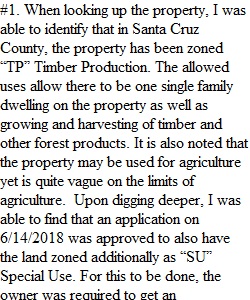


Q Regulatory Environment, Site History, and Soils 25 points SITE REGULATIONS The first step in understanding your site and potential management/design opportunities is to understand the regulations that guide what can--and cannot--be done on site. You should already know who owns the property from the site selection assignment, now you need to identify what jurisdiction the site is within (city, county). There are a variety of ways you can find out this information, including using AGOL to identify the political boundaries (e.g. add layer>Living Atlas>USA Counties) to find what county the property is located within. To find if the property is within the city limits, you will have to look at a city map--most likely available on line through the city website. Do NOT rely on the mailing address. Oftentimes an address will list a city but will be physically outside the city boundary. Once you have determined what political boundary, the property is within, we need to identify relevant regulations that may apply to the property. These include: • City/County: Zoning--what is the property zoned? What are the permitted uses? • Land Management Policies/Regulations: If the property is publicly owned (most likely), then the property is subject to a variety of additional management policies and regulations. Research what management policies regulations might apply to this property. For example, if the property is a city/county/state park, research their website to see if you can find a Park and Open Space Comprehensive Plan, or master plan or similar document. This document will identify the park you are investigating, categorize it as a specific type--for example “open space” “multiple-use” etc. (the city/county may use different terms), and provide management guidelines/regulations for that type of property as well as preliminary objectives. • As you are researching these websites and documents, you may also come across a specific park management plan for the site you are investigating. There is a good chance the information about regulations that apply on the site are within that plan. Q1: Two paragraph summary of what you found or interpret to be the major local and federal laws/regulations relevant to this site. (5 points) If you cannot find any of these documents, describe the local and federal laws/regulations might be relevant on this site and why. Also describe your search process--why do you think you could not find regulatory information about this site? SITE HISTORY Research the history of the site. Previous and historic land owners, previous and historic land uses. Your county assessor’s office is a good place to start with identifying previous land owners and uses. The current land manager (e.g. city or county parks department, etc.) may also have information on previous land owners and the history of the site. Depending on the property, you may or may not find any historic information. If this is the case for your site, then research key historic land uses and events in the area of the site. All sites have an indigenous past. To see what native peoples used your site visit: https://native-land.ca/ Q2: Provide a two-three paragraph summary of the site history. Be sure to site your sources. (5 points) Q3: Create a land acknowledgement for your site (5 points). See here for some very helpful tips about how to create a culturally sensitive land acknowledgement: https://guides.library.oregonstate.edu/land-acknowledgments SOILS: You may or may not have completed your site inventory/basemap assignment at this point. However, you’ll start assessing some of the physical environmental features in this assignment then can “ground truth them in later assignments. First we are going to examine the soils on the property. Go to the Web Soil Survey: https://websoilsurvey.sc.egov.usda.gov/App/HomePage.htm Click on the green button “Start WSS” and zoom in to the property you are investigating. Click on the square AOI (Area of Interest) and draw roughly the boundaries of the property to generate the AOI. Then click on the soil map tab to examine the soil types. (If you get an error message that the soil map is not valid at that scale, you can draw a larger AOI that encompasses your site.) Click on the Map unit name to get a full description of each soil type. Q4: What soils that exist in the AOI? What soil type is predominant on the property you are investigating? Read through the pop-up window of the predominant soil type--what information did you find interesting and why? One paragraph summary (5 points). Next click on the Soil Data Explorer Tab and click on the “suitabilities and limitations for use” sub-tab. You’ll see all sorts of suitabilities and limitations ratings. Select ONE suitability/limitation rating that relates to something you would like to see on this site, for example trails, or picnic areas. Please read the full description to get a full understanding of the rating. Q5: Why did you select this rating--how does it relate to the activity you are interested in? View the rating and then discuss what it means to the site you are investigating. Are there areas that are more suitable for activities you are interested in developing on this site? Why do you think that these areas more suitable? If no suitable areas were identified for the rating you selected, discuss why you think this may be the case. Two paragraphs plus include a screen shot that shows your suitability rating results (example given below). (5 points) Please note: You can find the same soil data without the suitability ratings in AGOL: Just search for USA soils and you’ll see a several different soil maps (erodibility, farm class, etc.) pop-up. You might find these maps more useful when conducting your site suitability analysis. However the level of detail information is less than in WSS. Brandon Carico
View Related Questions